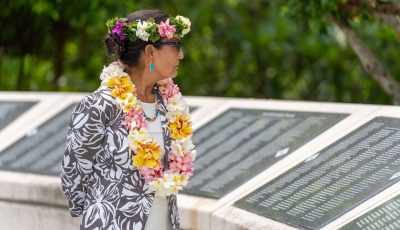The need to return to learning history: World War II
World War II isn’t a textbook lesson for our Chamorro people of the Mariana Islands. As we can attest, our grandparents, great grandparents, parents, uncles, and aunts were war survivors, whether they lived on Guam, Tinian, or Saipan. World War II came to our island chain for the entire duration of the war that we had no part in starting or ending.
Our Chamorro Pacific Islander civilization lived through and saw firsthand the vast destructive power that hot war between powerful nations brought to our Mariana Islands. Today, it is still important to remember that history has all kinds of lessons to teach us. So many of us know family stories of relatives suffering, dying, being tortured, or enduring extended hardship from Japanese occupational actions, actual fighting between Japan and the United States throughout the Marianas, and the subsequent American militarization of our island chain. Hundreds of our Chamorro families were permanently displaced as Guam most especially became the site of a major multi-tiered American military buildup.
But historically speaking, it was really the Atlantic where most of the American military resources went, not the Pacific
When World War II began, the American military focus wasn’t the Pacific; it was in the Atlantic and Europe. Most American ships and shipping routes were based on the eastern seaboard of the United States, not the north American West Coast. When the war began in 1941 and Pearl Harbor was attacked, the U.S. Navy had relatively fewer ships assigned to the Pacific. The number of aircraft carriers were in the single digits, and many of the destroyers used in the Pacific were from World War I. During this time, Japanese zero airplanes were the most sophisticated airplanes roaming the Pacific, not American fighters.
How did the American military win in the Pacific?
Despite America not having the requisite resources in the Pacific at the onset of World War II, the U.S. was determined to quickly produce new military ships and aircraft at a clip not seen before in American history. The attitudes held by the most senior admirals who were planning and prosecuting the fight throughout the Pacific—King, Nimitz, Spruance, and Halsey come to mind—believed that the U.S. must prepare and accept the possibility of seeing massive losses of ships and men as a necessary evil to beat Japan.
Many mistakes were made by the U.S. especially during the first half of the war in the Pacific due in part to the lack of training previously offered for amphibious operations and jungle warfare. Thousands of Americans lost their lives because of incorrect predictions of tidal charts, a lack of pre-invasion naval bombardment and inadequate numbers of landing craft used during Pacific Island invasions.
Marine Corps and Army leaders were simultaneously at each other’s throats because each organization wanted to conduct tactical beach landings for their own benefit. The Army wanted to take on the Japanese empire from the south while the Navy wanted to fight westward across the Central Pacific.
Our ancient home, the Mariana Islands, and its reference as Japan’s Inner Empire
Our Mariana Islands chain was viewed as the “inner empire” of Japan by the U.S.
While our Chamorro family members were being mistreated, suffering, or being placed into forced labor situations by the Japanese military in Guam and receiving ever harsher treatment from increasingly anxious Japanese military personnel in 1943, American Adm. Nimitz and Adm. King concluded at the same time that invading our Mariana Islands the following year would help the U.S. defeat Japan without the need to invade the Japanese home islands.
Fleet Adm. King, a particularly circumspect man, understood the importance of working with the Army Air Corps toward this end. King quickly figured out that the newly produced B-29 Superfortress aircraft was ideal to launch the most lethal attacks against the Japanese homeland because the B-29 was the newest weapon of air warfare now on the scene that could lug 10,000 lbs worth of bombs across vast distances.
American liberation of our Chamorro people was not part of the decision-making process of America’s top military decision-makers during the war
Adm. King, Adm. Nimitz, Adm. Spruance, Gen. Douglas MacArthur, and the American Joint Chiefs of Staff did not plan to rescue or liberate our Chamorro people. It wasn’t part of the operational plan of action.
Gen. MacArthur and Adm. Nimitz were, instead, at odds over military operational matters. Adm. Nimitz ultimately prevailed and, in partnership with Adm. King, won approval from the Joint Chiefs of Staff to invade our ancient Mariana Island homes, Palau, the Carolines, and Mindanao, with the intent of eventually moving on to China, Formosa, and Luzon and using these areas to launch final attacks against the Japanese homeland.
While this was happening, Japan’s military leaders decided that Tinian would be the key location to house land-based air forces. Saipan was to be the location for a naval fleet headquarters. None of this ever fully materialized because Japan did not have the resources to properly fuel and maintain its dwindling maritime fleet.
Raymond Spruance, a soft-spoken introspective admiral, personally made the decision and approved the order of battle to first attack Saipan, then Tinian, then Guam. Spruance rationalized that taking our Mariana Islands was required for an American forward operating air and naval base because our ancient Pacific Island chain was the ideal location to then initiate follow-on attacks that would better position the United States to [eventually] defeat Japan. The people of Tinian know what happened after that.
Fast forward to today—we are now preparing for Liberation Day parties and remembrances. Let us also take a moment to think about how decisions made in the past, and perhaps in the present, by key military leaders from powerful nations close by or far away have affected our entire ancient Pacific Islander Chamorro civilization over most of the past century.



























